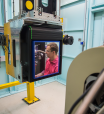Specialist expertise and capabilities at ANSTO enable an understanding and improvement of current and advanced nuclear fuel materials
With a well-established portfolio of nuclear research and the operation of Australia's only nuclear reactor OPAL, ANSTO scientists conduct both fundamental and applied research on fuel for current, advanced, and future nuclear technology systems.
















